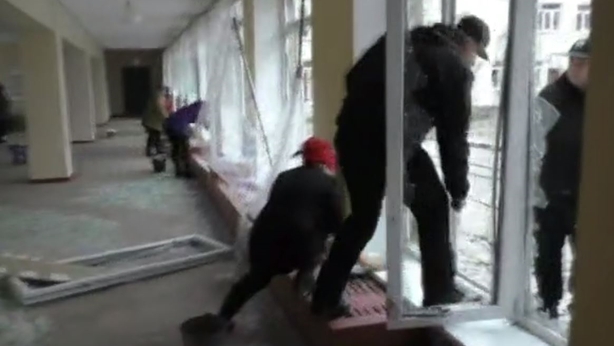Fighting in eastern Ukraine has escalated to the worst level in months, according to officials monitoring the conflict.
The Organisation for Security and Co-operation in Europe said it had recorded 16,000 ceasefire violations between 11 and 17 December, up by more than a third compared to the week before.
The OSCE's comment came after the shelling of a frontline village wounded eight civilians and destroyed or damaged dozens of homes.

The UN's OCHA humanitarian arm says people are fleeing the area in blizzard conditions.
A Russian-backed insurgency erupted in 2014 and the bloodshed has continued despite a ceasefire deal that was meant to end a conflict in which more than 10,000 people have been killed, with casualties reported on a near-daily basis.
The Organisation for Security and Co-operation in Europe said "we note with concern a sharp deterioration in the security situation with ceasefire violations reaching levels not recorded since February this year".
In February, a surge of violence around the government-held industrial town of Avdiivka cut off power and water to thousands of civilians on the front line.
Chief OSCE monitor Ertugrul Apakan said the latest escalation reflected an established trend "in which a recommitment to the ceasefire by the sides was followed by a steady increase in the level of violence, culminating in fierce fighting".
Mr Apakan's comments followed warnings from aid agencies over the humanitarian situation in the eastern Donbass region, particularly given Monday's attack on the government-controlled village of Novoluhanske.
Eight civilians were wounded and more than 50 buildings were damaged in the shelling, which also temporarily cut power supplies, the regional Kiev-controlled Donetsk administration said.
The US State Department said the humanitarian situation was "dire" because of the shelling, which it blamed on Russian-led forces firing Grad multiple-launch rockets.
The US State Department also voiced concern about fighting around the Donetsk water filtration station, which has a system of pipes that carry chlorine gas.
"If those were to go off in this area, which is close to where people live, it could be potentially devastating," State Department spokeswoman Heather Nauert told a briefing.
She said civilian water workers were trapped in the station's bomb shelter and could not get out because of fighting.

